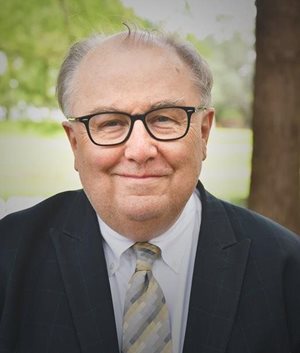Mobility Matters - 2024 Spring
In this issue:
North Texas Leads State in Electric Vehicle Growth
Texas High-Speed Rail Projects Receive Additional Planning Funds
Michael Morris, P.E.: Our Past Can Help Us Connect to the Future
Background Helps Bivens Bring People Together
EPA Grant Program Could Provide Funding to Help DFW Air Quality
Region Making Progress on State Safety Goals
North Texas Leads State Electric Vehicle Growth

Electric Vehicle ownership is surging in Texas, led by Dallas-Fort Worth. The state EV charging infrastructure has also seen steady growth. There are currently over 3,000 charging stations throughout the state, and plans are underway to further bolster the network, including repairing current chargers that are not working.
The electric vehicle movement continues across the country. Texas is no exception, as electric vehicle registrations are on the rise across the state. Closer to home, the Dallas-Fort Worth region alone has seen an increase of approximately 60% in EV registration in the past year, the highest of all the major metropolitan areas in the state. Kaufman County experienced a 70% increase in EV registrations, while Denton and Collin counties each experienced at least 60% growth. Dallas County is home to the most registered EVs in the region with over 25,000.
With the rise in EVs on the road, the state EV charging infrastructure has also seen steady growth. There are currently approximately 3,000 charging stations throughout the state and over 8,000 chargers. For more, visit https://afdc.energy.gov/stations/#/find/nearest.
Charging facilities are commonly at retail establishments and office buildings, allowing users to charge their vehicles while they shop, enjoy a meal or get important work done at the office. Dallas County currently has approximately 60 DC fast chargers available, not including Tesla chargers.
The federal government has stepped up efforts to expand the network of chargers, ensuring that EVs that hit the streets can be charged with confidence. Texas is set to receive over $400 million from the Bipartisan Infrastructure Law over five years to create an EV charging network. The Texas Department of Transportation is developing a network to enable EV owners to travel confidently across the state for work or pleasure. TxDOT plans to bolster the state’s charging infrastructure in two phases.
Phase 1 includes installing DC fast charging stations in recommended areas from an ongoing study along designated corridors every 50 miles. DC fast charge plugs can charge a battery to 80% capacity in approximately 40 minutes. NCTCOG will assist with Phase 2 of this plan in North Texas, which will focus on improving the infrastructure of both rural and urbanized areas. To learn more about these efforts, view the project map or participate in an ongoing survey, visit https://txdot.mysocialpinpoint.com/tx_ev_plan. While the number of chargers is important to ensure EV owners have the confidence to move about the region freely, so is network reliability. NCTCOG has won a grant that could help the region repair or upgrade up to 230 charging ports across 124 sites in North Texas. Priorities include:
- Sites not close to existing charging stations
- Increasing access in key areas such as multifamily properties, grocery stores and retail locations
- Connecting the region to other areas
The project is expected to cost $4.5 million, with $3.66 million coming from the grant. Additionally, NCTCOG has been awarded a $15 million federal grant to install up to 100 charging ports across the region.
The charging network is important to widespread adoption of electric vehicles. But as EVs continue to grow more popular, policymakers have also examined the impact of this expansion on transportation funding, since electric vehicles don’t pay traditional gas taxes. The Texas Legislature recently approved Senate Bill 505, which implements an annual registration fee to help make up for what they do not pay at the gas pump. Electric vehicle owners will pay $400 to register a new electric vehicle and $200 per year upon renewal of their registration.
return to top
Texas High-Speed Rail Projects Receive Additional Planning Funds
High-speed rail from Fort Worth to Houston recently took another step forward when the federal government announced the project has been included in the Corridor Identification and Development Program. Up to $1 million in additional planning funds will be provided for proposed high-speed rail service along the corridor, the Biden-Harris administration said.
The North Central Texas Council of Governments submitted the Fort Worth-to-Houston project (via Dallas), and Amtrak submitted a separate application for the Dallas-to-Houston line; both applications propose using the corridor that Texas Central received a Record of Decision on from the Federal Railroad Administration between Dallas and Houston.
NCTCOG has been planning the North Texas line, which would run along Interstate Highway 30 from Fort Worth to Dallas, with a stop in Arlington, and connect to the Dallas-to-Houston project. Through the Dallas-Fort Worth High-Speed Transportation Connections Study, NCTCOG examined 43 potential alignments, with high-speed rail along the IH 30 emerging as the preferred method to connect people seamlessly from throughout the region to the planned Dallas-to-Houston route via a one-seat ride.
The DFW High-Speed Transportation Connections Study is set to move into a National Environmental Policy Act (NEPA) analysis, focusing on route alignment, possible station locations and potential social and environmental impacts. In addition to the planning funds, inclusion in the Corridor ID Program is considered an acknowledgement of the need to advance project development and explore partnership opportunities as well as positioning the project for future federal funding to support design and construction.
return to top
A Message from Michael Morris, P.E.: Our Past Can Help Us Connect to the Future
 2024 is a significant milestone for transportation in North Texas. It marks 50 years since the designation of the North Central Texas Council of Governments as the Metropolitan Planning Organization (MPO).
2024 is a significant milestone for transportation in North Texas. It marks 50 years since the designation of the North Central Texas Council of Governments as the Metropolitan Planning Organization (MPO).
In April 1974, our Executive Board authorized NCTCOG as the MPO for almost 3 million residents of North Texas. In the ensuing years, this region has seen remarkable changes, including the addition of more than 5 million people. That averages out to more than a million people every 10 years with a growth rate now at 1 million persons every 7 years.
Our region now boasts a combined population of over 8 million people. To serve the needs of so many customers, our transportation system has had to innovate. Dynamically priced managed lanes, guaranteed transit, light rail, regional rail, award winning aviation and community-based transit and bicycle-pedestrian facilities continue to mature. In the next 50 years, road construction will still be part of our lives. But we also know a healthy transportation system requires more than additional lane miles. We must take care of the infrastructure we have and manage congestion in anticipation of continued growth.
Land use, safety, broadband and unmanned aircraft systems will supplement our needs along with Class 1 railroads, high speed rail and transportation technology.
How can we apply the lessons we’ve learned to ensure the generations that follow enjoy an even better quality of life?
Reconnecting Communities
For one, we can reconnect communities that were divided as the interstate highway system was taking shape in the 1960s and ‘70s. The system that created direct routes through metropolitan areas to help people move more efficiently than ever before also bisected neighborhoods.
Planners in North Texas and throughout the nation are trying to remedy this. Whether through the reimagining of Interstate Highway 345 in downtown Dallas or the construction of pedestrian caps over some of our busiest freeways, we can restitch communities, thereby enhancing quality of life. Klyde Warren Park, 5 acres of greenspace spanning Woodall Rogers Freeway in Dallas, is a magnificent example of how to turn modern infrastructure into a community asset. We are replicating this success in other parts of the region. Southern Gateway Park was a similar facility conceived over Interstate Highway 35E to connect Oak Cliff.
The concept of reknitting is not limited to freeways. In Fort Worth, the East Lancaster Complete Streets and Transit Technology Project will transform a corridor that used to be part of the transcontinental Bankhead Highway into a roadway that supports multiple mobility options for local businesses and residents. The corridor will be rebuilt to include technology transit, bicycle lanes and sidewalks. Landscaping, additional lighting and community-based economic destinations are also planned, as well as broadband internet infrastructure. All these improvements will give the community a sense of pride while connecting them in ways we could only have dreamed of 50 years ago.
High-Speed Rail
With the help of our valued federal, state and regional partners, NCTCOG continues to lay the groundwork for high-speed rail. In the next 50 years, the nation will be dominated by megaregions. Linking Dallas-Fort Worth with our biggest metropolitan areas by high-speed rail will ensure our residents are able to efficiently participate in the commerce of tomorrow.
A proposed high-speed rail line that would link Fort Worth and Arlington to Dallas is in the environmental phase and could emerge as soon as late 2024 ready for construction. Late last year, the federal government admitted the Fort Worth-to-Houston high-speed rail corridor into the Corridor Identification and Development Program, awarding it up to $1 million for additional planning activities. This project has the potential to reshape transportation, making travel between two of the nation’s most populous regions safer and more efficient and creating the gateway to Austin, San Antonio, and Laredo.
Tomorrow’s Transit
As our region continues to transform, we owe it to residents and employers alike to embrace a more comprehensive, inclusive transit vision that provides service to those areas accustomed to public transportation, as well as those areas currently without it. I call this Transit 2.0. Think of it as a vision of what public transportation can look like tomorrow.
The NCTCOG Regional Transportation Council and Executive Board have hired consultants to help the region leverage its transit successes to develop a seamless system capable of serving a region with more than 11 million residents. Our three public transportation providers – Dallas Area Rapid Transit, the Denton County Transportation Authority and Trinity Metro – have done a terrific job serving their customers over the years. But much of our growth is occurring outside the boundaries of these valued partners of ours.
Broadband
Equal access to education, telemedicine and job interviews is critical as well as the use of technology to eliminate food deserts, “a rising tide raises all ships,” and our responsibility is for all boats to be lifted in the harbor. Broadband creates such a tool. Our transportation investments occur at the neighborhood, regional and international logistics levels. Focus is placed on all zip codes regardless of income.
We have always understood connecting people safely and efficiently to be one of our primary jobs as transportation professionals. When NCTCOG was thrust into its role as the MPO 50 years ago, much of our focus was on roadways. We’ve spent the past 50 years leaning about the importance of interconnectedness and how each element of the transportation system works together to ensure the success of our region. It is a system of systems. Let us spend the next 50 applying these lessons to create a region that moves people more safely and efficiently than we could have imagined when we started.
After all … mobility matters.
return to top
Background Helps Bivens Bring People Together
Regional Transportation Council Member Profile: Gyna Bivens, Fort Worth Mayor Pro Tem
 After Gyna Bivens was elected to represent District 5 on the Fort Worth City Council in 2013, she noticed a common thread linking many calls and emails her office was fielding: Residents were asking basic questions.
After Gyna Bivens was elected to represent District 5 on the Fort Worth City Council in 2013, she noticed a common thread linking many calls and emails her office was fielding: Residents were asking basic questions.
For instance, people wanted to know whom to call if their trash wasn’t picked up, an important issue but one Bivens knew could be handled more efficiently. Bivens represents one of the fastest-growing cities in the country, and while the needs of its residents have changed over the years, she believes education is key to good public service. If people understand the basics, they feel empowered.
“If you can educate people on the simple things, it gives you time to focus on the complex,” she said.
She created a series of cards with contact information to help people answer commonly asked questions. The results were so positive, similar cards soon began springing up in other parts of the city as her colleagues noticed their effectiveness.
District 5 stretches from Interstate Highway 35W on the west side, eastward to Arlington and includes a mix of historic neighborhoods and new developments. Revitalizing neighborhoods has been high on her list since taking office. Stop Six, which received its name for being the sixth stop on the Dallas-Fort Worth Interurban, is one of the many neighborhoods on Bivens’ radar.
“After talking to developers after I got elected, I asked them,” Why won’t you build in Stop Six?” she said. “They basically told me, ‘It’s the zoning that you have.’” Stop Six had a historic overlay, which made it difficult to draw new development. Since that designation was rescinded, in 2016, there has been a 66% increase in new housing in Stop Six.
Bivens has been advocating for the members of her district as a member of the City Council for a decade, but she is a familiar voice to many North Texans. The current Fort Worth mayor pro tem served as a corporate spokesperson and a radio and TV reporter before that.
Bivens credits her career as a news reporter for giving her the skills to be an effective public servant. She learned to dig for truth and look for answers. She worked as a reporter at San Antonio in the 1980s, covering many important stories, including the rise of former Mayor Henry Cisneros, the first Hispanic to lead a major US city. Bivens also worked in the Dallas-Fort Worth media.
“I think that ability to communicate has helped me talk about things in my district more effectively than I would be able to but for that skill,” she said. Like many elected officials, Bivens wears many hats professionally. When she is not tending to constituent matters at City Hall, Bivens is helping connect management-level professionals to corporations seeking top talent, as executive director of North Texas LEAD. The organization was started by a group of CEOs who realized their companies needed more diverse leadership and hiring more women, minorities, even older workers, could help their companies grow. One of the biggest issues Bivens sees is drawing the right development to the area. The Trinity Lakes transit-oriented development, anchored by a new Trinity Railway Express Station, is an example of that right kind of development. The new station is under construction and will be part of a 1,600-acre master-planned TOD with retail and residential.
Bivens first got a taste of transportation policy in the late 1990s, when she was appointed to serve on the executive committee of the Fort Worth Transportation Committee, now known as Trinity Metro. She would serve two stints as chair of the committee, gaining an appreciation of the importance of all transportation entities working together for the good of the region.
In 2021, she was appointed to the Regional Transportation Council and elected to a one-year term as chair in June 2023. Bivens uses many of the same skills she’s learned throughout her career to lead the 45-member transportation policymaking body. One of those skills, honed on the radio, is efficiency, allowing her to keep members on task so they can allocate money to the many transportation projects that in turn keep the region moving.
It’s more than a responsibility for efficiency that inspires Bivens.
“For the most part, everybody comes to that table realizing that we need to do what’s good for the region,” she said. “You may not get exactly what you want specifically for your city, but I admire the way RTC members come together and discuss, debate, negotiate for the good of the region.” RTC members understand they are making decisions that will be felt far beyond their borders. And although the debate can be vigorous at times, the members maintain a regional perspective, she said.
“Everything we do is going to impact more than just the cities, the counties that we come to the table representing,” she said. “The idea of being able to stay focused on the greater good is something I commend all RTC members for.”
return to top
EPA Grant Program Could Provide Funding to Help DFW Air Quality
Air quality is an ongoing issue in North Texas, where 10 counties are currently in nonattainment for ground-level ozone. The North Central Texas Council of Governments manages several programs that empower the public and private sectors to play an active role in improving ozone levels and overall air quality in the region.
To continue efforts to improve air quality and reduce greenhouse gases and other harmful air pollutants, including ozone precursors and particulate matter, NCTCOG has been awarded a grant through the Environmental Protection Agency’s Climate Pollution Reduction Grants (CPRG) program. The CPRG program has two phases. The first phase provides funding to develop regional plans to improve air quality. The Dallas-Fort Worth area has received $1 million from the CPRG planning grants and NCTCOG has met with the public through a series of in-person open houses meant to encourage a dialogue between planners and the communities they serve.
NCTCOG is leading the development of the Dallas-Fort Worth Air Quality Improvement Plan with the help of local partners. The DFW AQIP is a comprehensive plan to improve air quality, enhance sustainability and promote equity. The measures in the DFW AQIP could be implemented in Phase 2 of the program, which provides $4.6 billion to implement regional plans developed with the planning grants.
Local governments interested in applying for the $4.6 billion in funding are encouraged to participate in the development of the DFW AQIP to ensure projects of interest to their communities are included and made eligible for Phase 2 funding. For more, visit www.publicinput.com/nctcog-cprg.
return to top
Region Making Progress on State Safety Goals
There has always been a push to keep Texas roads safer. However, in recent years, there’s been an even stronger emphasis on roadway safety. Roadway fatalities are the result of a crash and there are many factors that cause them. In 2022, the top 5 contributors to serious-injury or fatality crashes on limited access facilities (highways) were:
- Speeding (31%)
- Driver related – driver inattention, driving without headlights, road rage, following too closely (16%)
- Impaired driving (12%)
- Failing to drive in a single lane (10%)
- Faulty evasive action (8%)
In North Texas, there was a slight decline in crashes reported between 2021 and 2022, led by Hunt County. The bigger improvement came in the fatality rate. In 2022, the region reported 864 fatal crashes, 6% fewer than the previous year. (Crash data for 2023 should be available this spring.)
Many counties saw decreases in their fatality rates, including Denton, Hunt, Kaufman, Parker and Rockwall counties, which all experienced remarkable declines. Denton County fatalities decreased by 23.88%. Hunt County saw a 60.53% decrease and Kaufman County saw a 30.56% decrease. Similarly, Parker County fatalities decreased by 46.43% and Rockwall County saw a 30% decrease.
Expectations are high. The Regional Transportation Council has a policy statement that even one death on the transportation system is unacceptable. The Texas Department of Transportation’s Vision Zero initiative calls for roadway fatalities to be reduced by 50% by 2035 and eliminated by 2050.

Speeding is a top contributor to serious and fatal roadway crashes in North Texas. State transportation leaders have called for the elimination fatal crashes by 2050. Law enforcement officers work tirelessly to keep the region’s drivers safe and will be counted on even more to meet this policy goal.
Driver Assistance
Making the roads safer requires the collaboration of drivers, transportation planners and partners both in the region and throughout the state. The Regional Roadside Assistance Patrol Program is a mobility assistance program, which has patrols operated by the Dallas County Sheriff’s Office, Tarrant County Sheriff’s Office and the North Texas Tollway Authority.
MAPP services on the LBJ and NTE TEXpress corridors are provided by private sector partners. Over the past year the program had almost 150,000 assists. The most common assistance calls were for driver assistance or a stalled vehicle, courtesy check-ins and protection to first responders.
Safety Campaigns
Drive Aware North Texas is an educational campaign aimed at improving negative driver behaviors that are leading contributing factors for serious injury and fatality crashes in North Texas. To learn more about this initiative, visit www.driveawarentx.org.
Planning
Additionally, the NCTCOG Regional Roadway Safety Plan was approved in March 2023. The goals of this plan include:
- Eliminate fatal crashes from all modes of travel by 2050
- Prioritize safety in roadway project selection and provide guidance on countermeasure development to partner agencies
- Fund and implement safety projects and polices equitably to ensure safe transportation access for all road users
- Foster a culture of safety that utilizes the safe systems approach through work with partners; and develop behavioral and educational countermeasures to address dangerous driving behaviors
- Identify problems before they occur with a proactive approach to roadway safety
- Improve quick roadway clearance strategies by collaborating with police to effectively enforce traffic rules
To learn more about the Regional Roadway Safety Plan, visit https://www.nctcog.org/RSPReport. Statewide efforts are also being made to ensure safer roads for all. A statewide TxDOT and MPO Safety Task Force worked to develop a five-year proposal to identify best practices, recommendations and innovative ideas to reduce fatalities, injuries and crashes. Additionally, TxDOT committed $50,000 to MPOs statewide to support safety efforts.
return to top
For a list of upcoming Transportation Department events, visit https://nctcog.publicinput.com/#events
